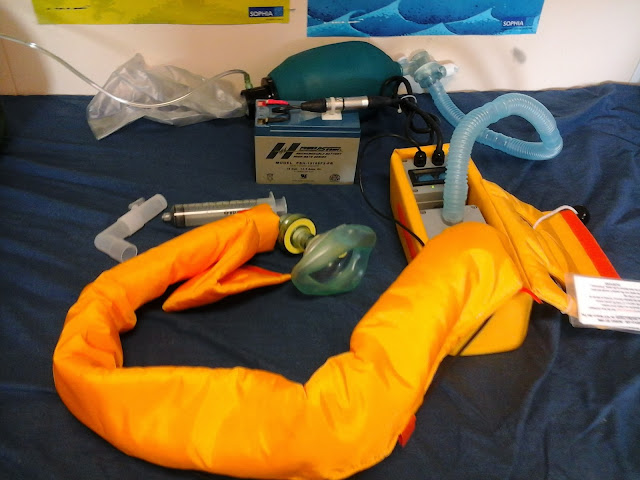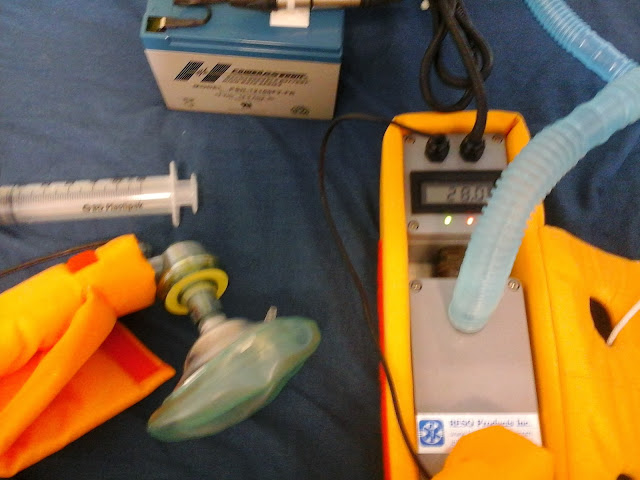Hypothermia
RES-Q-AIR ® Model Ht 1000
Hypothermia treatment,
described in many current protocols such as the State of
Alaska Cold Injuries Guidelines (Revised 1/2005) recommend
that heated 108°F (42°C) and humidified oxygen or air
should be administered
The RES-Q-AIR ® is a
non-invasive Core Rewarming System, going right to the heart
of the problem for hypothermia and trauma victims, by
thermally stabilizing the "critical core"
temperature in the field and during transportation en-route
to the hospital.
* Pre-hospital
stabilization; continued cooling if not arrested, can lead
to ventricular fibrillation of the heart. Preventing cardiac
dysrhythmias must be the highest priority, patients with a
temperature below 30°C or 80°F, may not respond to
defibrillation. Thermally stabilizing a patient is necessary
to prevent cardiac complications.
* Inhalation rewarming; is
a simple, non-invasive treatment suitable for active core
rewarming in the field, available to rescuers, paramedics
and first responders to thermally stabilize the
"critical" core temperature in the field.
* Core rewarming; is a
very effective and safe treatment for all levels of
hypothermia, donating heat directly to the head, neck, and
thoracic core (the critical core) through inhalation of warm
water-saturated air or oxygen.
* This method also warms
the hypothalamus, the temperature regulation center, the
respiratory center, and the cardiac center at the base of
the brainstem, this rewarming of the central nervous system
at the brainstem reverses the cold-induced depression of the
respiratory centers and improves the level of consciousness.
* This method also warms the hypothalamus, the temperature regulation center, the respiratory center, and the cardiac center at the base of the brainstem, this rewarming of the central nervous system at the brainstem reverses the cold-induced depression of the respiratory centers and improves the level of consciousness.
Alaskan protocol and JAMA. The Res-Q - Air Oxygen Warming system increases probability of survival for hypothermia victims.
The Res-Q - Air system is specially designed to provide warm, humidified air or oxygen, enchance heat directly to the 'core'.
Helps stabilise core temperature of hypothermia victims, reducing possible cardiac complications in the field.
Simple, positive automated electronic temperature control.
May be operated from any 12V DC power source (i.e. car, boat, ATV, helicopter).
Current drain is only 6 amps.
Minimal training required to operate:
Pour in 70ml of water
Plug into power source
Apply the face mask
 |
| RES-Q-AIR ® Photo By Dr. Ramon Reyes on Western Regent Vessel |
 |
| RES-Q-AIR ® Photo By Dr. Ramon Reyes on Western Regent Vessel |
Alaskan protocol and JAMA. The Res-Q-Air Oxygen Warming system increases probability of survival for hypothermia victims.
The Res-Q-Air system is specially designed to provide warm humidified air or oxygen, donates heat directly to the 'core'.
- Helps stabilise core temperature of hypothermia victims, reducing possible cardiac complications in the field.
- Simple, positive automated electronic temperature control.
- May be operated from any 12V DC power source (i.e. car, boat, ATV, helicopter).
- Current drain is only 6 amperes.
Minimal training required to operate:
- Pour in 70ml of water
- Plug into power source
- Apply the face mask
- DONE!
More information in the link

AED Automatic External Defibrillator . UN compacto, economico y seguro https://emssolutionsint.blogspot.com/2019/08/aed-automatic-external-defibrillator-un.html
DESCARGA MANUAL PDF en Español



